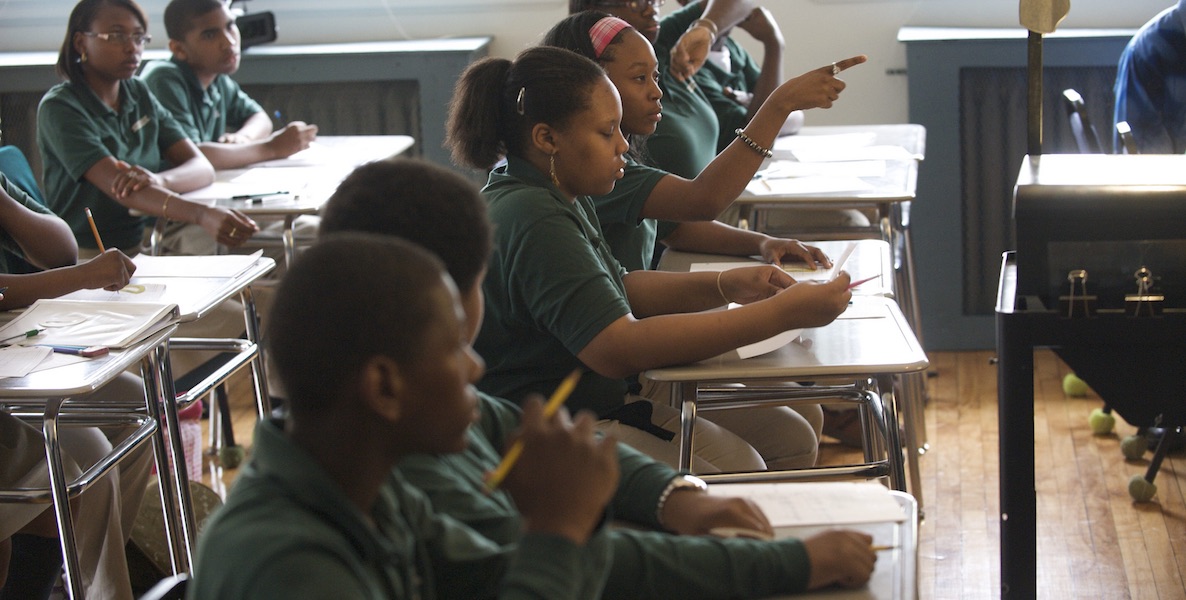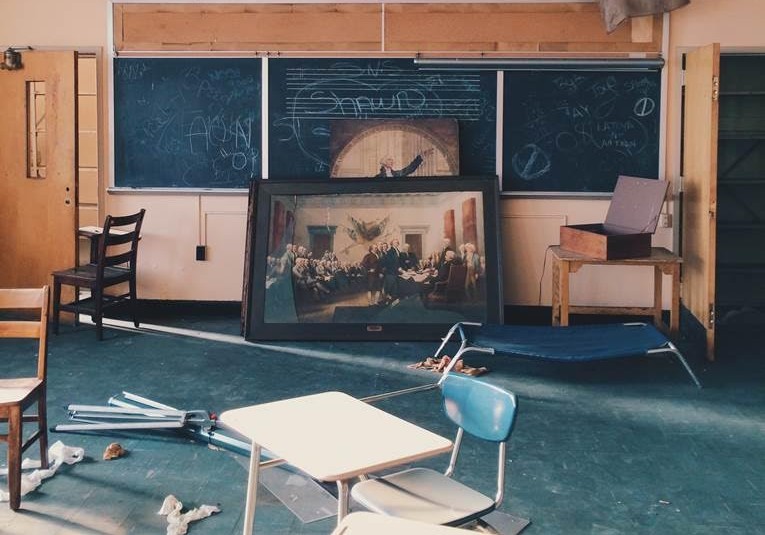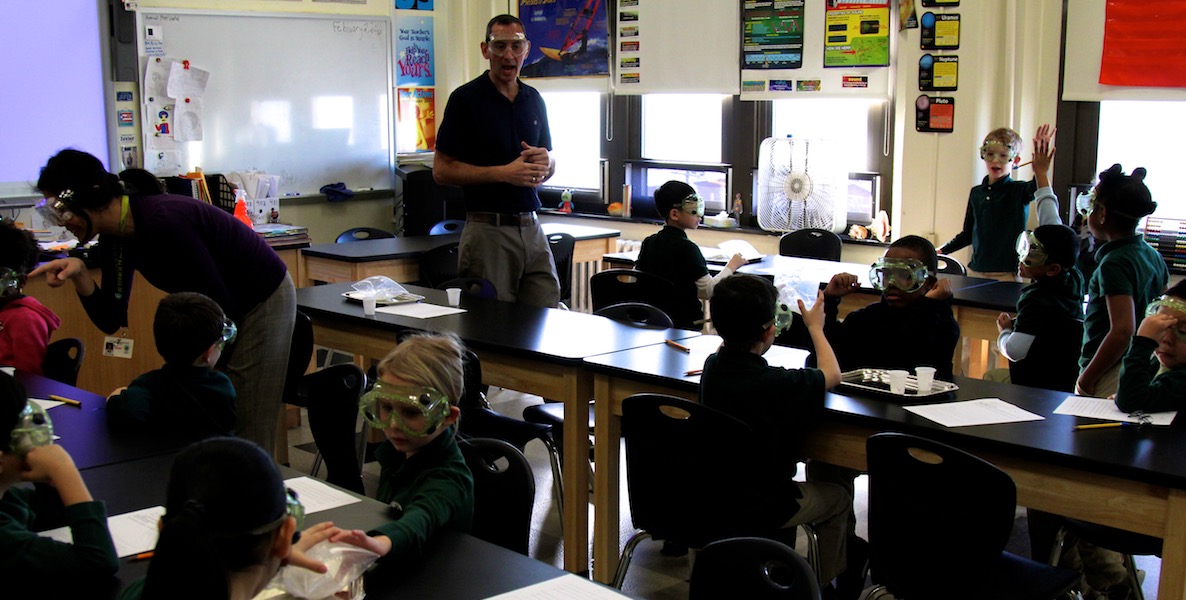When Karen Clancy moved to Queen Village 10 years ago, she didn’t give schools much thought—she and her husband didn’t have children yet. So they were pleasantly surprised to find out a few years ago that their address would allow their daughters—now 5 and 3—to attend one of Philly’s most celebrated neighborhood schools, William M. Meredith Public School.
Then, last fall, she found out her daughter’s kindergarten seat was not guaranteed. For the first time, Meredith—a school that has become increasingly overcrowded—held a lottery to fill its 60 kindergarten slots. That meant, the School District said in a series of community meetings, that even children who lived in the school’s catchment area might not be able to attend Meredith. And there would be no sibling preference; in other words, even families with one child in the school already were not guaranteed a slot for their incoming kindergartener.
The news hit Queen Village like an earthquake. Angry parents sent letters, and circulated a petition imploring the District to put their kids in the same schools, so they wouldn’t be pulled in different directions. Some families, after all, had moved to the neighborhood for the sake of the school; they expected, rightly, that the school would demand a certain amount of parental involvement—something difficult enough to squeeze into a busy schedule without having two schools make demands on their time. Given the volatile nature of any situation involving public schools in the city, the reaction was not surprising.
“Nebinger is not lesser than,” says Ben Schindler, president of the school’s Home and School Association. “We want people who want to be here. The worst-case scenario for Meredith parents in this is they don’t get what they want for one year. The worst case for Nebinger is taking spots from kids who want to be in the school for years.”
Except here’s the catch: The 20 children not selected in the lottery are to be admitted to George W. Nebinger, a neighborhood school at 6th and Carpenter, just three blocks away from Meredith, at 5th and Fitzwater. And even then, they only have to be at Nebinger for one year. In first grade all Meredith children would be re-enrolled in their local school. That means all this agita and anger was over one year at a school serving their neighbors that is increasingly viewed as a promising school where children thrive.
This is about more than these two schools in this one South Philly neighborhood. It’s the story of what can happen when you get too much of what you’ve been asking for—increased parental involvement and commitment to neighborhood schools. Within that changing dynamic, it touches on hot button issues of race, class and gentrification—all the sticky points in any schools (or, indeed, city) conversation. And it reveals the cracks in an inequitable school system in which the jockeying for good seats produces winners and losers, even if just for the short term.
Meredith is the second school in the District to have a lottery for kindergarten; the Penn Alexander School, in West Philly, initiated one in 2014, to put an end to parents camping outside the school for days in order to register their kids in kindergarten. It is a problem still so unusual to Philadelphia—a city known more for parents avoiding public schools than embracing them—that no one seemed able to figure out how to handle it well, not the District, or the school, or the parents.
“We attended meetings all fall and were told the school has been steadily getting more crowded for years,” Clancy says. “Why was there no plan? They just said, ‘We’re working on it.’ The whole thing was really off-putting.”
The issue in Queen Village is heightened by a confluence of factors: The neighborhood, with one civic association and one set of boundaries, is divided into two schools with very different histories, records and populations. Meredith has spent the past decade enjoying a reputation as one of a few neighborhood schools always at the top of the list for success and desirability. Its PSSA scores hover between 65 and over 90 percent proficiency. It has significant private funding coming in from the community: At its annual auction a few weeks ago, the Meredith Home and School Association raised more than $130,000—a new record even for a school known for record-breaking fundraisers. That’s partly because its population is wealthier than Nebinger, and the District as a whole.
Meredith used to be a school that children throughout the city could choose in the school selection process, which kept it relatively diverse; it now pulls exclusively from its Queen Village catchment, roughly between Columbus Boulevard and South 9th Street, South and Christian streets, an area with relatively high property values. This has increasingly made it an isolated enclave that doesn’t reflect the city or district. Some 25 percent of Meredith students live in poverty, compared to 75 percent District-wide. It is increasingly white, and upper middle class, which accounts in part for the school’s test scores, which are influenced by language and socioeconomic factors. The school highlights the uncomfortable reality that all public schools, even within one neighborhood, are not equal.
This touches on hot button issues of race, class and gentrification—all the sticky points in any schools (or, indeed, city) conversation. And it reveals the cracks in an inequitable school system in which the jockeying for good seats produces winner and losers, even if just for the short term.
Nebinger for about the last five years has been on the upswing, in terms of academic offerings, enrollment and community involvement. Its highest test score, for 3rd grade math, is in the 45 percent proficiency range, above both the District average and where it was a few years ago—though not a shining success. It has an active Friends group and Home and School Association, and (until she left to help start a new high school this spring) a much-lauded principal, Ahn Brown. It is one of those schools that public school advocates point to as a reason to remain in the city and send children to neighborhood schools.
In other ways, the metrics favor Nebinger. Class sizes top out at 26 or 27, reducing also the student teacher ratio. At Meredith, the two first grades have 35 and 36 students each. Nebinger is bigger inside, has a brand new playground, and—something more important to some than others—it is diverse both racially and socio-economically. Like much of South Philly, the Nebinger catchment—a much smaller area between Christian and Washington, Columbus and 10th—has a heavy immigrant population. It also is small enough that the school is not likely to fill up anytime soon exclusively with children from its surrounding neighborhood. That means there is room for children who live outside the catchment, and whose families choose Nebinger in the District’s School Selection Process.
For Nebinger, this has meant a boon in the thing that all public schools—and their advocates—clamor for: An involved school community. “Nebinger is not lesser than,” says Ben Schindler, president of the school’s Home and School Association. “I don’t care what anyone looks like, their socio-economic status—we want people who want to be here. The worst-case scenario for Meredith parents in this is they don’t get what they want for one year. The worst case for Nebinger is taking spots from kids who want to be in the school for years.”
Throughout the city, well-meaning civic-minded people are forming Friends Of groups to adopt their local neighborhood school, and urging their neighbors to give it a try—often accompanied by a general disdain for the role that charter schools play in the District. Those people have tended to be white and middle class. In predominantly black and poor neighborhoods, schools have struggled to develop the same community support. (To their credit, Friends of Neighborhood Education coalition is working to change that.)
Overcrowded neighborhood schools is an interesting problem to have in Philadelphia. It means that families have decided to invest in their local schools in the best way possible—by sending their children there. That is happening in several pockets of the city, particularly those areas surrounding Center City. In South Philly, the jump in immigration has meant a population boom in certain neighborhoods; and it is also one place where young middle class families have adopted their local schools, forming “Friends Of” groups, and increasingly sending their children to the local public. District Spokesman H. Lee Whack says he expects Meredith will have a lottery again next year, but no other schools yet. But principals at some—like Andrew Jackson Elementary in East Passyunk—see the spectre of overcrowding hovering over them.
The District will need to solve this problem, in a way that doesn’t turn families away from public schools all together—something Clancy witnessed in Queen Village this year, when friends moved away or opted for private schools rather than subject themselves to the lottery. Whack says the District considered a number of options before going to a lottery: change in grade configuration, merging Nebinger and Meredith, leasing or purchasing space, boundary or feeder changes, expanding the Meredith building footprint, and installing portable buildings. Meredith Principal Lauren Overton says those options are still on the table. But so far, the will—from the community and the schools—has not been to push for any of these ideas that could be a model for future schools facing the same problem (of success).
Overcrowded neighborhood schools is an interesting problem to have in Philadelphia. It means that families have decided to invest in their local schools in the best way possible—by sending their children there.
“These are hard choices, but you have to make them,” says Schindler. “We have demands for seats in our school. But the District, rather than saying how do we increase supply, says how do we squash demand? That’s what the lottery does. And we’re losing families who want a public education.”
For Clancy, the dilemma of the school lottery became both simpler and more complicated when she did the thing school advocates urge all families in the city to do: She visited Nebinger. And she loved it. She decided she’d rather her daughter attend the lesser-known gem in the neighborhood. But Clancy was told the District could not guarantee her a spot if she declined the lottery, and though she tried to create a swapping system for parents who preferred Meredith over Nebinger, she felt she could not risk having no local option for kindergarten.
In April, Clancy found out her daughter was one of the lucky ones who got in to Meredith. But a few weeks later, she gave up the seat and enrolled her in Nebinger anyway. “My husband and I live in a tiny house—our whole lives are so constrained,” she says. “Being in a school with more space was very appealing. We are hopeful and excited about our decision.”
Header photo by Lauren Summers for Philly School News







